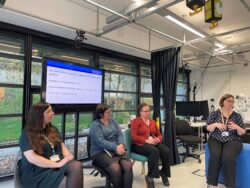22
10
.25
Workplace Wellbeing and the Internet – a final blog
The Workplace Wellbeing and the Internet (W-WATI) project ran from September 2024 to October 2025 as part of the Horizon Digital Economy’s Welfare Campaign. On October 29th we ran an event to discuss our findings with attendees from local workplaces and members of the University of Nottingham. We also launched a summary report of the project: Workplace Wellbeing and the Internet final report

The project was founded on the recognition that the Internet can have both positive and negative impacts on wellbeing in the workplace. We brought together a team with expertise spanning computer science, robotics, engineering, social science, philosophy, psychology and linguistics in order to conduct a suite of activities to address different dimensions of wellbeing in the workplace as they relate to the Internet.
Following a review of existing literature we established a working definition of wellbeing to use across the project: an overall subjective feeling of satisfaction, optimism or happiness about life; functioning well and with a sense of purpose and feeling content about the activities we engage in. We drew on this definition run an online survey. Of 248 respondents 63.7% rated their workplace wellbeing as somewhat or extremely good. Thirty-six per cent (36%) said that Internet technologies affected their wellbeing positively and 15.3% negatively. A set of in-depth qualitative studies similarly found that participants viewed the Internet as having a largely positive influence on their working lives, but with some areas of detrimental impact. For instance, our participants told us that the Internet offers valuable flexibility in the workplace however too much time online can cause burnout and stress. Support from employers is vital in helping employees to manage an appropriate offline-online balance and technological tools can also assist with workload management and boundary setting. Some job roles inevitably require employees to come into contact with harmful online content or hostile online interactions. Employees differ in their preferences for how best to support wellbeing during these experiences but benefit from strategies that involve social support, mood improvement, burden reduction and exercising control to reduce risks.
In addition to investigating how the Internet impacts wellbeing in the workplace we also explored the potential for Internet-connected technologies to foster workplace wellbeing. We prototyped and tested two novel and promising interventions. The “Cheerbot” socially assistive robot is designed to boost feelings of wellbeing through fun, collaborative activities. The empathy training tool uses conversational AI to help managers and HR professionals practise empathetic communication.
These various research activities produced a range of insights which have informed a set of guidance for employers and employees on wellbeing in the workplace. Our guidance emphasises that there is no ‘one-size-fits-all’ approach to wellbeing and that different preferences for wellbeing support should be respected. In addition, employers should engage meaningfully with wellbeing initiatives rather than viewing them as a tick box exercise, plus be mindful that employees may distrust technological solutions through fear they are being used for workplace surveillance. Looking to the future, the wellbeing impact of Internet-connected technologies depends less on the nature of the tools at our disposal, and more on the ways in which those tools are used. It is unhelpful to make sweeping generalisations about the relationships between the Internet, the workplace and wellbeing; instead, it is essential to understand the nuances involved.

















